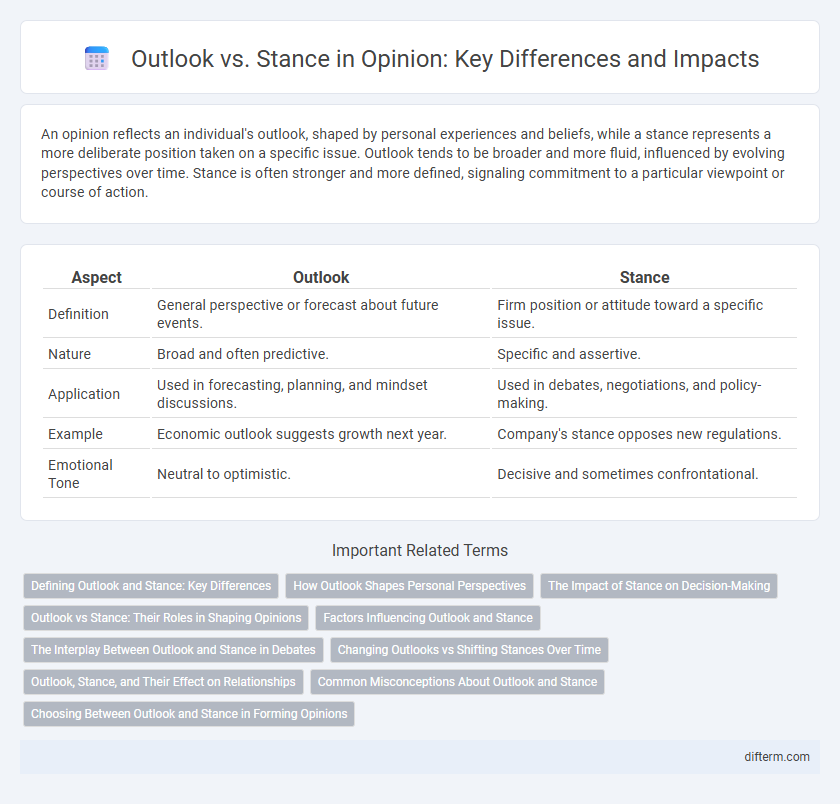An opinion reflects an individual's outlook, shaped by personal experiences and beliefs, while a stance represents a more deliberate position taken on a specific issue. Outlook tends to be broader and more fluid, influenced by evolving perspectives over time. Stance is often stronger and more defined, signaling commitment to a particular viewpoint or course of action.
Table of Comparison
| Aspect | Outlook | Stance |
|---|---|---|
| Definition | General perspective or forecast about future events. | Firm position or attitude toward a specific issue. |
| Nature | Broad and often predictive. | Specific and assertive. |
| Application | Used in forecasting, planning, and mindset discussions. | Used in debates, negotiations, and policy-making. |
| Example | Economic outlook suggests growth next year. | Company's stance opposes new regulations. |
| Emotional Tone | Neutral to optimistic. | Decisive and sometimes confrontational. |
Defining Outlook and Stance: Key Differences
Outlook refers to a broad, future-oriented perspective shaped by experience and expectations, while stance is a specific position or attitude toward an immediate issue or situation. Outlook influences general mindset and long-term decision-making, whereas stance reflects a more focused, situational judgment or response. Understanding these distinctions helps clarify how individuals and organizations frame their views and actions.
How Outlook Shapes Personal Perspectives
Outlook significantly shapes personal perspectives by influencing how individuals interpret experiences and anticipate future events. A positive outlook fosters resilience and openness, enabling adaptive responses to challenges, whereas a negative outlook can limit perception and reinforce biases. Understanding this dynamic highlights the power of outlook in directing attitudes and decision-making processes.
The Impact of Stance on Decision-Making
Stance profoundly influences decision-making by shaping how individuals interpret information and prioritize values, leading to more consistent and resolute choices. Unlike outlook, which reflects general attitudes or perspectives that can be fluid, stance embodies a committed position that drives specific actions and responses. Understanding the impact of stance clarifies why decision-making processes often reflect underlying beliefs and principles rather than just situational analysis.
Outlook vs Stance: Their Roles in Shaping Opinions
Outlook represents a person's general perspective or long-term vision influenced by experiences, while stance reflects a specific position taken on an issue based on current beliefs and evidence. Together, outlook and stance interact dynamically to shape opinions by providing a broad framework and a focused viewpoint, respectively. Understanding their distinct but complementary roles enhances the analysis of how opinions evolve in different contexts.
Factors Influencing Outlook and Stance
Factors influencing outlook and stance often overlap but diverge in emphasis; outlook is typically shaped by broader contextual elements such as cultural background, past experiences, and societal trends, while stance is directly informed by specific values, beliefs, and situational assessments. Psychological factors like cognitive biases and emotional responses play crucial roles in determining one's stance on issues, affecting decision-making and action readiness. External influences including media narratives, peer pressure, and institutional norms continuously mold both outlook and stance, highlighting their dynamic nature in opinion formation.
The Interplay Between Outlook and Stance in Debates
The interplay between outlook and stance in debates shapes how arguments are framed and perceived, as outlook defines the broader perspective while stance conveys a specific position on an issue. Effective debaters align their stance with a coherent outlook to enhance credibility and persuasive power. Recognizing this dynamic helps audiences critically evaluate the consistency and depth of arguments presented.
Changing Outlooks vs Shifting Stances Over Time
Changing outlooks reflect evolving perspectives influenced by new experiences or information, often indicating a gradual adaptation of thought. Shifting stances, however, involve more deliberate repositioning on key issues, typically signaling a strategic or ideological realignment. Understanding the nuanced difference between these concepts is crucial for analyzing personal growth and public opinion dynamics effectively.
Outlook, Stance, and Their Effect on Relationships
Outlook shapes how individuals perceive situations and influences emotional responses, while stance reflects their specific position or attitude toward an issue. A positive outlook fosters empathy and openness, strengthening interpersonal connections, whereas a rigid stance can create conflict and misunderstandings. Understanding the interplay between outlook and stance is essential for building trust and enhancing communication in relationships.
Common Misconceptions About Outlook and Stance
Common misconceptions often confuse outlook with stance, assuming both represent fixed positions rather than flexible perspectives. Outlook refers to a broader, long-term way of viewing situations, while stance is an immediate, situational attitude toward specific issues. Understanding this distinction clarifies communication and fosters more nuanced discussions in personal and professional contexts.
Choosing Between Outlook and Stance in Forming Opinions
Choosing between outlook and stance when forming opinions hinges on recognizing that outlook represents a broader, long-term perspective shaped by values and experiences, while stance reflects a specific, immediate position on an issue. Emphasizing outlook allows for more flexible, evolving viewpoints, whereas stance provides clarity and decisiveness in debates. Effective opinion formation balances the comprehensive nature of outlook with the directness of stance to communicate beliefs convincingly.
outlook vs stance Infographic

 difterm.com
difterm.com